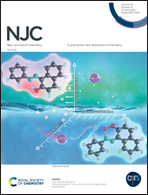Fe–CuP nanocubes for nitrate-to-ammonia conversion†
Abstract
The urgent need for effective and sustainable electrocatalytic nitrate reduction to mitigate global water contamination and foster fossil-free ammonia generation has driven extensive exploration of bimetallic non-noble metals in electrochemical applications. Herein, we present the development of an electrocatalyst, namely FeCu phosphide (Fe–CuP), which demonstrates high efficiency in the reduction of nitrate. The prepared samples exhibit exceptional catalytic activity in the electrocatalytic reduction of nitrate to NH3 in a neutral electrolyte. It is noteworthy that the Faraday efficiency reaches an impressive 89% at −1.5 V (vs. SCE), with NH3 yield of 0.6 mmol h−1 cm−2, surpassing the performance of the FeCu alloy. This superior performance can be attributed to the distinct surface morphology of the catalyst and its ability to facilitate rapid charge transfer, which is enhanced by the presence of phosphorus. Moreover, the Fe–CuP catalyst also demonstrates remarkable long-term stability making it an excellent candidate for practical applications. Thus, this work not only introduces a novel synthesis method for Fe–CuP but also establishes the efficacy of phosphorus in promoting nitrate reduction to NH3. These findings provide valuable insights into the advancement of electrocatalytic technologies for sustainable water treatment and ammonia synthesis.



 Please wait while we load your content...
Please wait while we load your content...